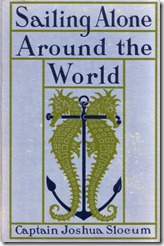 Cruising literature as a genre started with Joshua Slocum’s Sailing Alone Around the World published in 1899. Many who read it were motivated to reach for their own adventure, and many of those who succeeded also wrote up their experiences. More new sailors were inspired to leave the dock and more stories were subsequently chronicled. Now, over a century later, the cruising memoir tradition is alive and flourishing, exploding onto the Internet with myriad websites and blogs.
Cruising literature as a genre started with Joshua Slocum’s Sailing Alone Around the World published in 1899. Many who read it were motivated to reach for their own adventure, and many of those who succeeded also wrote up their experiences. More new sailors were inspired to leave the dock and more stories were subsequently chronicled. Now, over a century later, the cruising memoir tradition is alive and flourishing, exploding onto the Internet with myriad websites and blogs.
While Sailing Alone Around the World is a classic and Slocum’s adventures the inspiration for many sailors to take off and circumnavigate, I would have been equally interested to read the experiences and viewpoints his first wife Virginia who sailed the world at his side during thirteen years he was a commercial ship’s captain. By accounts, Ginny was a perfect partner for Slocum and took to their shared life at sea despite several misadventures and despite bearing and raising all their children on board. Wouldn’t Ginny’s perspective be a wonderful one to share? She sounds like an Admiral to me!
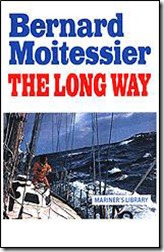 Since I have been writing this column, I have been looking for and collecting books about women cruising, and, of course, I’ve asked the Admirals for input. Because really, does a woman considering setting off on a voyage want to read adventure sagas of big storms, long passages, lee shores or shipwrecks that make up so many of cruising literature’s classics?
Since I have been writing this column, I have been looking for and collecting books about women cruising, and, of course, I’ve asked the Admirals for input. Because really, does a woman considering setting off on a voyage want to read adventure sagas of big storms, long passages, lee shores or shipwrecks that make up so many of cruising literature’s classics?
“The first book my future husband lent me to read about cruising was The Long Way by Bernard Moitessier,” remembers Debbie of Illusions. While many sailors consider Moitessier one of the great singlehanders of all times, Debbie read the book, took it back to her future cruising partner and said, “Anyone would have to be crazy to want to do what this man did!”
Most of the really good books I’ve found about women and cruising were written in the past ten to twenty years. Of course, in part that’s due to recent books being easier to find, but they also relate more directly to our current experience than many of the classics.
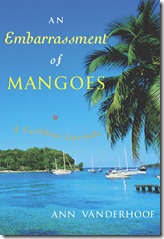 One of the most popular of these is Ann Vanderhoof’s An Embarrassment of Mangoes: A Caribbean Interlude. This is the lovely account of a Canadian couple’s decision to take a break from high pressure jobs and Toronto’s urban cold and sail south to the warmth of the Caribbean for a few years. Like most couples the idea comes easily, but the realities of preparing to go and actually getting underway nearly overwhelm the endeavor. As they persevere, the book blooms with wonderful descriptions of the Caribbean and, as Mary of I Wanda points out, “yummy recipes for using that readily-available but Strange-to-a-North-American produce that we all encounter down island.”
One of the most popular of these is Ann Vanderhoof’s An Embarrassment of Mangoes: A Caribbean Interlude. This is the lovely account of a Canadian couple’s decision to take a break from high pressure jobs and Toronto’s urban cold and sail south to the warmth of the Caribbean for a few years. Like most couples the idea comes easily, but the realities of preparing to go and actually getting underway nearly overwhelm the endeavor. As they persevere, the book blooms with wonderful descriptions of the Caribbean and, as Mary of I Wanda points out, “yummy recipes for using that readily-available but Strange-to-a-North-American produce that we all encounter down island.”
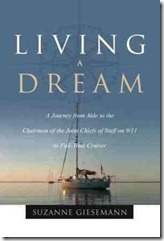 Some other excellent W&C books are Suzanne Geisemann’s Living A Dream, in which Suzanne, a former aide to the chairman of the Joint Chiefs of Staff (on 9/11!) juggles her mixed feelings about the cruising dream with her husband versus the call of a high-powered career.
Some other excellent W&C books are Suzanne Geisemann’s Living A Dream, in which Suzanne, a former aide to the chairman of the Joint Chiefs of Staff (on 9/11!) juggles her mixed feelings about the cruising dream with her husband versus the call of a high-powered career.
Another is Gillian Outerbridge’s Going About! A Waterway Adventure. After a traumatic experience, Outerbridge, at 60, finally undertakes her dream of a solo voyage, one she makes over the course of two years through the waterways and canals of New York State and Canada in her 20’ Flicka. Dreams don’t have to be global.
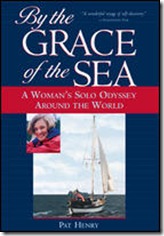 On the other hand, in Pat Henry’s By the Grace of the Sea : A Woman’s Solo Odyssey Around the World, the author struggles to get on her feet personally and financially after betrayal and bankruptcy by sailing alone around the world. The going gets heavy at times, but her salvation comes through her painting which grows from the seed of architectural sketches into an art that supports her through ups and downs right round the world.
On the other hand, in Pat Henry’s By the Grace of the Sea : A Woman’s Solo Odyssey Around the World, the author struggles to get on her feet personally and financially after betrayal and bankruptcy by sailing alone around the world. The going gets heavy at times, but her salvation comes through her painting which grows from the seed of architectural sketches into an art that supports her through ups and downs right round the world.
I also very much like Margo Wood’s (of Charlie’s Chart’s fame) homely story in A Prairie Chicken Goes To Sea of her transformation from a Canadian farm girl into a competent mariner. “Imagine my amazement when I found this book on board after my husband died,” says Debbie. “The fact that she kept her boat and kept cruising after her husband died told me that I COULD continue on if I wanted to badly enough.”
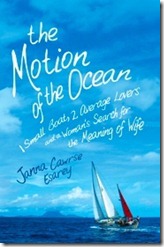 Themes of self-doubt, second thoughts, and anxieties weave their way through many of the cruising books by women for women. Unlike our men, we’re less inclined to just put on a bold face and soldier through. We also make a lot of our own anxieties, stirring them up like a bubbling cauldron.
Themes of self-doubt, second thoughts, and anxieties weave their way through many of the cruising books by women for women. Unlike our men, we’re less inclined to just put on a bold face and soldier through. We also make a lot of our own anxieties, stirring them up like a bubbling cauldron.
Janna Cawrse Esarey does a wonderful job of capturing this knack for angst of which we females are capable (to distract ourselves from other anxieties?) in her recent The Motion of the Ocean: 1 Small Boat, 2 Average Lovers, and a Woman’s Search for the Meaning of Wife. On their ambitious honeymoon – a two year cruise across the Pacific in the 35’ Dragonfly – Janna (who joins us now as an Admiral) finds the “passage from first date to first mate anything but smooth.” I really loved her irreverent look at emotions we all feel in some measure!
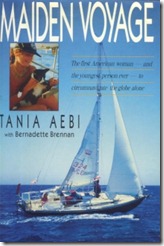 Several Admirals cite Tania Aebi’s now classic Maiden Voyage – her story of circumnavigating as a teenager with relatively little knowledge – as early inspiration in the “if-she-could-do-it-then-I-can” department. Karyn of Magic Carpet similarly recommends The Reluctant Mariner by Joanna Hackett, “a humorous and insightful account” of a woman on a circumnavigation carried “well outside her comfort zone.”
Several Admirals cite Tania Aebi’s now classic Maiden Voyage – her story of circumnavigating as a teenager with relatively little knowledge – as early inspiration in the “if-she-could-do-it-then-I-can” department. Karyn of Magic Carpet similarly recommends The Reluctant Mariner by Joanna Hackett, “a humorous and insightful account” of a woman on a circumnavigation carried “well outside her comfort zone.”
Karyn also recommends First Lady: A history-making solo voyage around the world, an account by Australian Kay Cottee of her record-breaking non-stop circumnavigation in 1988, and Elizabeth Thurston’s Dolphins At Sunset, “a woman’s perspective of cruising with a family and maintaining her self-esteem.”
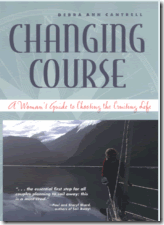 Several valuable volumes that also come recommended which are not so much cruising memoirs but books specifically aimed at cruising women are:
Several valuable volumes that also come recommended which are not so much cruising memoirs but books specifically aimed at cruising women are:
- Debra Ann Cantrell’s Changing Course : A Woman’s Guide to Choosing the Cruising Life,
- Diana Jessie’s The Cruising Woman’s Advisor ,
- and Suzanne Giesemann’s It’s Your Boat Too: A Woman’s Guide to Greater Enjoyment on the Water.
Cantrell’s book is the result of a five-year study interviewing over 100 cruising women in an effort to understand the process through which woman adjust to following their partners to sea!
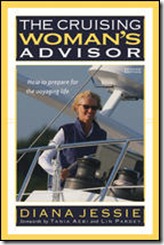 Jessie’s “Advisor”, much like the Admiral’s Angle, consults with over thirty contemporaries for perspectives on topics of interest to cruising women, while Giesemann’s second book, It’s Your Boat Too, is a manual specifically designed to “help women embrace the idea of being as knowledgeable as the captain.”
Jessie’s “Advisor”, much like the Admiral’s Angle, consults with over thirty contemporaries for perspectives on topics of interest to cruising women, while Giesemann’s second book, It’s Your Boat Too, is a manual specifically designed to “help women embrace the idea of being as knowledgeable as the captain.”
Must you read all these books before dropping a dockline? Not at all.
In fact, like me most of my Admirals picked up their cruising lit – including any of the big names in blue-water sailing – like Hiscock, Roth, Pardey, Dashew, etc.– after they were underway.
It’s important to remember that each of these cruising sagas (including all the web accounts you find on the Internet) are just one person or one couple’s experience and not a master plan for a “right way.” You take from them just what will aid you.
Ellen of Cayenne III observes that when she did happen to read some of those “authorities” after she’d been cruising awhile, she thought it was just as well she hadn’t read them before, because she might never have left! “My ignorance allowed me to develop my own cruising style – and now, I’m among the few cruisers we met in 1998 who are still aboard.”
Indeed, more than any volume of cruising literature, the books the Admirals felt most strongly about were their favorite references, the ones they take aboard and consult regularly, volumes you might think were more the province of the captain. So next month, in the last part of this topic, we’ll look at “An Admirals’ Reference Shelf.”
(Note: On www.womenandcruising.com we are launching a new page about the Cruising Woman’s Bookshelf. Send us your booklist recommendations.)
This article was published in the February 2010 issue of Latitudes and Attitudes.
Related articles (on this website)
- My Bookshelf – A Mental Voyage – Part 1 (Admiral’s Angle column #42)
- A cruising bookworm loves her new Ebook reader (Women and Cruising blog)
- Taking Passions Cruising (Admiral’s Angle column #41)
